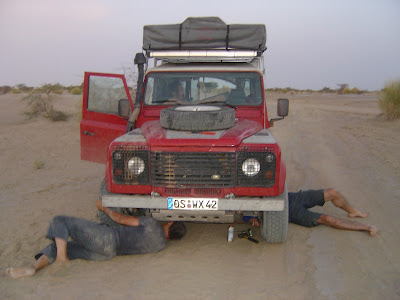56km East of Timbuktu, our clutch burned out. We were not even on a track, but travelling cross-country from the bank of the river Niger to the main piste, some 10km to the north. We were slightly lost and came upon some woven reed huts, and a man in deep blue robes was kindly walking ahead to show us the route to the main track when we came to a sudden halt with the unmistakable smell of burnt clutch plate. We were in a hollow, amid thick spiny scrub on low dunes. Happily we had other company also, as we had met Christophe and Judith in Timbuktu. They are travelling from Germany to South Africa in their Land Rover Defender, and we had decided to travel to Gao together, just in case of an event such as this.
We tried towing, but the sand was too deep and the car too heavy. The sun was low, so we made a quick decision to take our coordinates, grab our bags and return to Timbuktu in the Germans’ vehicle, about one and a half hours away on a rough sandy piste. The man in blue kindly offered his services as guardian of the car, and settled down under a thorn tree.
The day’s excitement was not yet over. On the way back, Christophe hit a sand trap, and, just as we did two days ago, landed on his steering rod and bent it. He is a mechanic and was completely unfazed – in ten minutes flat the bar was off, straightened roughly, and back on.
We returned to our friendly mechanics in the outskirts of Timbuktu. The chief was all set to leave immediately for the bush to remove the clutch, but we said it could wait til the morning. We gave him a description of the part, and he promised to track one down. Indeed, by 9.30 the next morning he was at the hotel, used clutch plate in hand – not exactly pristine, but serviceable. After a few hours of mysterious delay, our enlarged expedition set off. We had a driver, four mechanics, Judith and Christophe (who kindly stayed with us, delaying their own progress) in their own car, and two GPSs, without which we would never have found the car again.
On the way, the mechanics’ car broke a back leaf spring, and they fixed it with a bit of wood cut from a small tree, and plenty of wet rope. Their bush mechanic skills are incredible. For replacing a clutch, the Haynes Manual says:
Remove the transmission, or the engine. If no other work is to be carried out on the transmission, it is far simpler to remove the engine... Locating a suitable place to work is extremely important. If a garage is not available, at the very least a flat, level, clean work surface is required.
"Clutch Camp"
Needless to say, Timbuktu mechanics do not need a Haynes manual. In just two hours - in the sand, in the heat, in the middle of nowhere - they removed the exhaust and transmission and found that the spare part would indeed fit. Sadly, the other part of the plate was worn and cracked and would also need replacing. So, they left their tools and set off again for Timbuktu, while we made camp and cooked - red curry, with polish sausage, imported by Con.
At 7.30am, the mechanics were back with the part, and I have no idea how they found us without a GPS. By 10.00am, the car was back together and we were ready to continue our journey, a bit poorer but with gratitude and admiration for their quick and expert work.
Despite our remote location, it was amazing how many people dropped by to visit. On foot, camel and horseback, we had a series of visitors, many with headaches and other ailments. We dispensed paracetamol, which is at the limit of our medical competence.
On the bank of the Niger with Christophe, Judith and local residents
Back on track, lunch stop











No comments:
Post a Comment